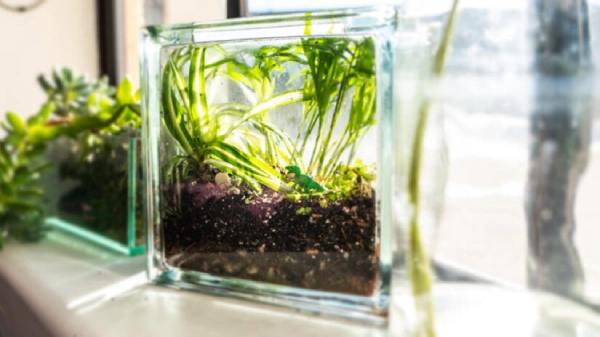
Glass Doctor provides a guide on creating a DIY glass terrarium:
|
Terrariums aren't just trendy, they're a fantastic way to incorporate live plants into your home or business. Terrariums are a great option for homeowners, renters and offices looking to incorporate low-maintenance plantings into their space.
Read on to learn how to build and care for your own DIY glass terrarium.
What Exactly Is a Terrarium?
A terrarium is just a transparent globe or deep bowl for housing live plants and, in some cases, small animals like frogs or invertebrates. They make for easy, hassle-free growing and, since they can be sealed, are ideal if you have small children or pets that are likely to disturb plants.
Just follow the instructions, tips and suggestions below for building a little living world of your own!
What do I need to make a terrarium?
- An Attractive Glass Container
Glass containers are inexpensive and widely available (think empty pickle jar or old coffee pot). You can also purchase decorative or specialized containers for a more sophisticated look. During this process, you'll need to decide whether your terrarium will be open or sealed. Sun-loving, water-conserving plants such as succulents are good for open terrariums, while humidity-thriving plants such as orchids, ferns and mosses are best suited for closed terrariums.
- Sand, Stones & Soil
Sand will keep plants from rotting and help with drainage. About a one-inch layer is needed, though this may vary depending on the size of the terrarium. For either type of terrarium, you'll also need pebbles for drainage, as well. You can even use broken pottery, tile or aquarium rocks. Layer over this with (possibly more) sand/charcoal mix.
Choosing the right soil is important because while terrariums don't need a lot of care, the soil is important. Most garden centers sell soil specifically for terrariums, although regular potting soil will work if it's high in organic material. Add a layer of soil over the sand mixture. Pack it tight to eliminate air pockets and make holes large enough for the plant roots. Now, your terrarium container should be about a third full, with this soil layer being the thickest.
- Plants
There are so many kinds of plants to choose from. Just keep in mind the types of plants (mentioned previously) that work for your type (open or closed) of terrarium. Choose them for the size and location (how much sunlight, etc.) of the container. Typically, plants shouldn't overlap or touch the sides of the container. Try not to overcrowd the space. Find slow-growing plants such as African violets, moss, creeping figs or baby's (or angel's) tears.
- Decorations & Occupants
If you've managed to leave room, get creative by adding small decorations to your terrarium. You can use shells, stones, figurines, toys – anything goes. If you have adequate space and conditions, you can even add frogs, worms or other small living animals to your terrarium!
What kind of maintenance is required for a terrarium?
- Watering
Use a small spray bottle to mist the plants in your terrarium daily. In an open terrarium, water the plants once a week, careful to avoid overwatering mosses and other plants that don't need as much. Soil should not be wet or dry but barely moist. Closed or sealed terrariums might almost never need watering. Just be sure to avoid direct sunlight to keep from hurting the plants.
- Pruning
Judiciously prune away dead or excess foliage as the plants grow to help prevent rotting.
- Animal Care
Of course, you'll also need to maintain any live animals you may have added to your terrarium. Animals should have plenty of space, food and water for comfortable and healthy living.
It's easy to see why terrariums are popular addition to any home or office. We hope you enjoy building and caring for your very own diy glass terrarium.
Need help with a custom glass project at your home? Contact the Glass Doctor location nearest you or schedule an appointment online.

